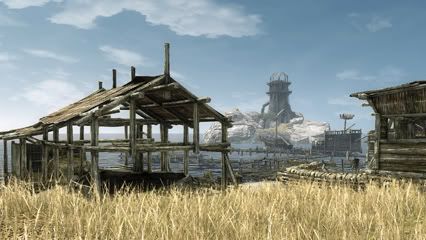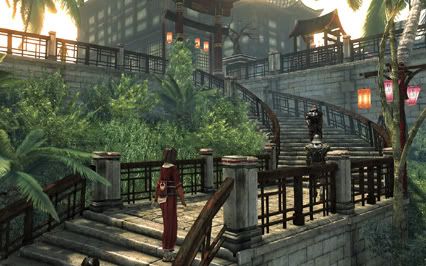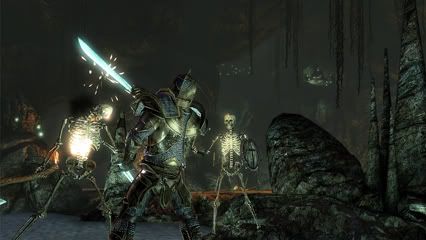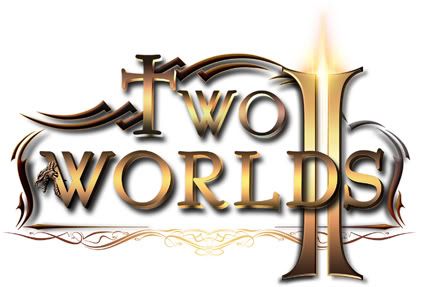James Seaman, Managing Director at TopWare Interactive, is excited about his game to the point of profanity. I’d rather not repeat some of his choice words, so I’ll just say he thinks Two Worlds II is going to be effing awesome. I had some time to speak with Mr. Seaman before the demo, and it’s clear that Seaman and his team have learned some hard lessons that will result in a much better game than the original Two Worlds.
Two Worlds II began as a second expansion pack to the first game, but quickly ballooned to something much more ambitious. “The things we wanted to do within the game were being limited by both the game engine as well as by the design of the world,” PR and Community Associate Joey Kobylinski explained as he began the demo. TopWare’s teams, spread world-wide from the US West Coast to Poland, decided to go back to the drawing board, building up an entirely new engine that could be optimized for Xbox 360, PS3, and PC in equal measure.
Looking at the Xbox 360 version of the game, the results are clear. Two Worlds II isn’t the next Uncharted, but it’s certainly giving Oblivion and Fallout 3 a run for their money. The game’s indoor areas are filled with unique details and physics interactions, all the while already running at a smooth frame rate. Similarly, its outdoor vistas are not only large in scope, but impressively varied. In my brief look at the game, Mr. Kobylinski took me through a murky swamp, a tropical beach, an expansive savannah, and an oriental-themed city.
Two Worlds II is not only 20-30% larger than the original game, but it’s also far more dense. According to Mr. Kobylinski, filling out the world with details was a big focus for the team. Most areas in the original were barren fields or caves, but environments in the sequel are crafted to be more interactive and unique. Small details like bits of wood wading in water, blades of grass waving in the wind, and rain running down stone walls gave each scene a sense of place.
 Set seven years after the original, Two Worlds II puts some distance between itself and that game without completely alienating fans. It’s the same world and the same evil forces pulling the strings, but a new mystery opens the game at the typical RPG starting point: escaping a prison with nothing but the clothes on your back. From there you’re left to explore, take on quests, and develop your hero.
Set seven years after the original, Two Worlds II puts some distance between itself and that game without completely alienating fans. It’s the same world and the same evil forces pulling the strings, but a new mystery opens the game at the typical RPG starting point: escaping a prison with nothing but the clothes on your back. From there you’re left to explore, take on quests, and develop your hero.
The game uses classless character progression, allowing players to upgrade themselves however they see fit. This freedom was one of the big strengths of the original game, and most of the concepts are maintained and improved upon. Players can focus on multiple disciplines, break them up into distinct load-outs, and then swap them on the fly. This allows them to, for example, weaken an enemy with magic, close the gap with archery, and then finish them off with a few sword strikes.
Magic is particularly extensive, featuring a deep card system that allows you to create custom spells. Cards act as modifiers for a spell; so if you acquired a multiplier card you could attach it to a fireball spell, and cast two fireballs. Stacking cards on a spell increases the casting cost, but also allows for some crazy combinations. Mr. Kobylinski showed me a few higher level examples, like a multi-direction lightning spell that raises a gang of zombies to fight by your side.
The deep customization options are combined with much improved combat. Active blocking and countering allow for a more timing-based response to attacks rather than relying on dice rolls. Archery allows players to fire from two different views and queue up multiple shots before firing. Lastly, Kobylinski showed off the Occulus, an item he described as a “medieval drone.” Players can assume control of the Occulus, scouting ahead for enemies as well as casting spells remotely.
 Two Worlds II wouldn’t be much of an RPG without the storytelling to back up all the combat and customisation. This was a major issue in the original game – it languished in stiff, awkward dialogue and cutscenes. But both Seaman and Kobylinski assured me that this was one of the major things they are addressing. “We just finished our first round of voice-over in Toronto last week and we’re in the process of implementing that, lip-synching and everything like that.”
Two Worlds II wouldn’t be much of an RPG without the storytelling to back up all the combat and customisation. This was a major issue in the original game – it languished in stiff, awkward dialogue and cutscenes. But both Seaman and Kobylinski assured me that this was one of the major things they are addressing. “We just finished our first round of voice-over in Toronto last week and we’re in the process of implementing that, lip-synching and everything like that.”
TopWare has also completely reworked how conversations are presented. “In a lot of classic, open-world RPGs you enter a conversation and it becomes the camera flip thing,” Kobylinski explains. “It’s this exercise where he says this, he says that, he says this. And while it reads very well in a lot of these games, we wanted to do something a little more unique in this game, a little more flavourful. So what we did was actually allow the player to move around within the conversation environment, pan the camera, pull the camera forward and back to make the characters themselves pop.” The closest comparison would be the original Assassin’s Creed, where players could wander around the room throughout the conversation. “It makes it feel more like the conversation is a natural part of the game world as opposed to being this separate mechanic,” he adds.
Further enforcing the emphasis on storytelling, Kobylinski showed us one of the game’s many collectible books. Typically only a handful of pages, books can sometimes be as long as 40 pages and feature story details that work their way back into the main game. “Some of [the books] will lead players to alternate quest-lines and conversations you may not have had the option of engaging in before.”
 On top of all this, the game features some extensive multiplayer options for up to 8 players. Mr. Seaman explained two of the modes – one is an RTS-inspired “Village” mode, and the other is a co-op prequel story to the single-player game. Village mode allows each player to build up their own town, sending out units to attack the other player’s villages. Despite the ambitious nature of putting an RTS in an RPG, Seaman makes it sound trivial, “We already had the framework and the background with Earth 2150, so it was a natural fit.”
On top of all this, the game features some extensive multiplayer options for up to 8 players. Mr. Seaman explained two of the modes – one is an RTS-inspired “Village” mode, and the other is a co-op prequel story to the single-player game. Village mode allows each player to build up their own town, sending out units to attack the other player’s villages. Despite the ambitious nature of putting an RTS in an RPG, Seaman makes it sound trivial, “We already had the framework and the background with Earth 2150, so it was a natural fit.”
He was a little less confident when it came to the co-op mode though. The way it works currently, 8 players explore the world until they hit a dungeon. The dungeon becomes much like an instanced zone in an MMORPG, with a limit of 4 players. I asked what the other 4 players would do in the meantime. He replied, “We’re still working on that.”
That’s either a bad sign for Two Worlds II, or just a sign that the game still has some development to go. After the reception of the original game, TopWare still has a lot to prove. That said, Two Worlds II is a clearly ambitious title that I’m happy to report is shaping up to be the next big western RPG.
Update: It seems that, during my chat with Mr. Seaman, some of the finer details of Two Worlds II multiplayer were lost in translation. It turns out the game’s Village mode is less competitive RTS and more cooperative strategy – players build up their personal villages and have the option to invite their friends to help out with quests or share resources. And as for the game’s co-op mode, players actually assemble in a matchmaking lobby, choose a quest based on the number of players (quests can be limited to 2 players or allow the max of 8), and hop in. There is no open-world element to the co-op mode.



















The dearth of multiplayer action RPGs this generation is frustrating. Sure, I enjoyed Oblivion, but I know I would have enjoyed it more with other people. Sacred 2 might have been promising if the game would run smoothly long enough to find out. It’s almost been 4 years since the PS3 launch and still nothing to replace the Baldur’s Gate: Dark Alliance or Champions of Norrath series on the PS2. Now to hear that the only coop action rpg option for Two Worlds II is a prequel story is depressing. I wish they would drop that aspect and just enhance the single player story. I suppose I just wish that the next generation machines could do what my PS2 could, meaning 4 player (online and offline) coop through the main campaign. Where is Snowblind? Can’t they do something about this?
Two worlds 2 probably have more story and because of that its hard to add The coop multiplayer option. I played baldurs gate and champions and i think they are a little diferent of gameplay, they are truly action, two worlds its a mix of action and story. But you are rigth with more people is always more enjoyable. But you know they want to please every type of player and because of the complexity there are always some things in the game development that go wrong.
If they did only single player probably there was people complaining about that. People are never satisfied and they want more and more. but the perfect game will never exist and two worlds 2 will not be perfect to, but they are struggling to make a trully good game and for that they deserve my respect.
I really wish they would figure out the multiplayer, I’ve been looking forward to a Ps3 MMO for a very long time. If they could figure this out I’m sure they could sell any expansion they made.
I disagree about the whole concept of needing coop to be a sort of add-on to the single player experience rather than its own separate thing; and the whole all or nothing sentiment in focusing solely on single player is a cop out. Single player is not the same thing as multi-player but with more players, nor should it be treated as such.
First off, Sacred 2 was not a failure because of how it ran if you had the hardware to run it. One of its key let downs was actually allowing multiple players to play through a storyline that was intended to be for a single person; that didn’t translate well because it made the challenge go way down and the experience was much less significant (among other things, like the story not being very engaging). And I think the same case could be justified for any game: Single player is its own experience so a game environment not intended for multiple players will suffer if coop is improperly introduced.
In short, they did the smart thing by tackling each task as a separate entity and the game play will likely become more engaging as a result of the care and attention devoted to each aspect of this game. Not to mention, co-op is not the only form of multi-player in Two Worlds 2: Let’s not forget there are many competitive and social modes as well like PvP and building up our own villages to trade and commerce with others. Let’s not sell this game short before we’ve at least experienced it for ourselves, shall we?